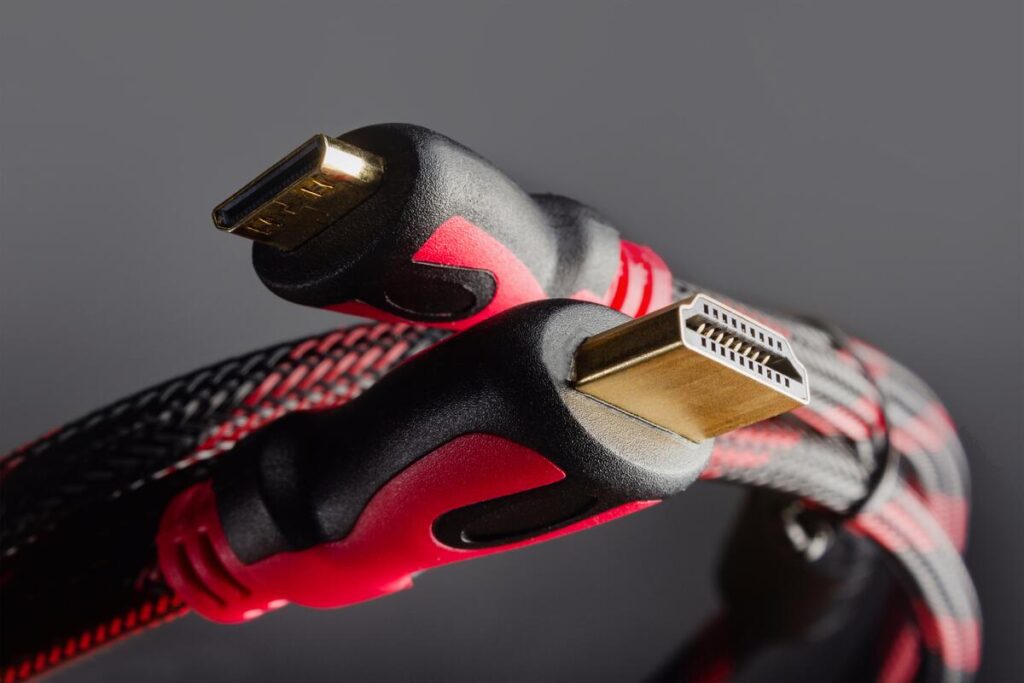Do OLED TVs Need Special HDMI Cables? (Explained)
Disclosure: Tech Parasol is supported by its readers. When you purchase through links on our site, we may earn an affiliate commission. Thank you.
- OLED TVs don’t need special HDMI cables.
- A high-speed or premium high-speed Category 2 HDMI cable will work in most cases.
- An ultra high-speed Category 3 HDMI is required for high frame rates or high resolutions (120 fps or 8K).
OLED TVs are known for their exceptional picture quality. But does that mean you need a special type of HDMI cable in order to take full advantage of what this type of TV has to offer?
Well that’s what you’re about to find out.
Let’s get to it.
Here’s what you need to know about OLED TVs and HDMI cables
OLED TVs don’t require special HDMI cables. But when transferring 4K resolution video from an external device a “premium high-speed” category 2 HDMI cable is recommended. Most people however will find that a normal “high-speed” HDMI cable will work in most cases.

That being said, if you don’t have a games console, Blu-ray player or streaming device, then you don’t need a HDMI cable at all. You can just watch the TV as is using the Smart TV interface or via over-the-air channels.
But assuming you do have external equipment that you’d like to connect up to an OLED TV, there are some things that you need to know.
Can I use my old HDMI cables with an OLED TV?
Most likely, if your old HDMI cables aren’t too old, are good quality and they are a “high-speed” Category 2 HDMI cable, then it will work with an OLED TV.
Category 2 HDMI cables support 4K video at a maximum of 60 frames per second.
So you won’t have any problems when watching a Ultra-HD Blu-ray or streaming 4K HDR movies from a device such as an Amazon Firestick or Chromecast with Google TV.
But, if you have an older Category 1 HDMI cable, then you may need to upgrade.
However, if you are only streaming 1080p content (full-HD) or less, then a Category 1 cable will do just fine.
Check out the table below for the different types of HDMI cables:
| HDMI Cable Type | Bandwidth Capability | Max Resolution/Frame Rate |
| Standard Speed (Category 1) | 4.95 Gbps | 720p @ 60 fps and 1080i @ 60 fps |
| High Speed (Category 2) | 10.2 Gbps | 1080p @ 60 fps and 4K @ 30 fps |
| Premium High Speed (Category 2) | 18 Gbps | 4K @ 60 fps |
| Ultra High Speed (Category 3) | 48 Gbps | 8K @ 60 fps and 4K @ 120 fps |
How to test your cables
The best way to test your cables is to try them because some cables are well made enough to support higher bandwidth signals than they’ve been tested to.
Also, because HDMI cables are “digital” cables, they will either work correctly or they won’t work at all.
HDMI cables are also a lot less susceptible to noise and interference than analog cables were.
If your cable isn’t capable of transferring the amount of bandwidth you require, then you will either get “sparkles” (basically missing pixels), an intermittent picture or no picture whatsoever.
Unfortunately, you can’t tell which type of HDMI cable you have simply by looking at it.
You have to try it to find out.
When would you need to upgrade your HDMI cable?
If you notice any pixel drop outs or the picture is intermittent or not displaying at all, you may need to upgrade to “Ultra high-speed” Category 3 cable or a “Premium high-speed” Category 2.
Premium High Speed HDMI cables are still Category 2 cables but are capable of handling bandwidths of up to 18 Gbps.
These cables will handle almost any 4K video that you care to throw at it, such as 4K video at 60 frames per second.
They can even support 8K resolutions at certain frame rates.
In addition, they have additional bandwidth available for the BT.2020 color space (more colors) and 4:4:4 chroma sampling (uncompressed, all luminance and color data sent).
But you would need to upgrade to an Ultra High Speed HDMI cable when streaming 8K video at 60 fps or 4K video at 120 fps.
More than likely, you are only going to encounter 120 fps content when you connect up a games console or a PC with a high-end graphics card.
Also, there are very limited options when it comes to streaming 8K content at the moment.
If you are not streaming at these resolutions and framerates, then a “high speed” category 2 HDMI cable will probably suffice.
Having said that, some Blu-ray players are capable of upscaling the quality of the content by boosting the color bit depth and the color subsampling.
When this extra data is combined with higher framerates, such as 60 frames per second, the amount of bandwidth required could exceed what a high speed HDMI cable is capable of transmitting.
Does HDMI 2.1 require a new cable?
If you want to watch 4K at 120 fps or 8K video at 60 fps, then you’ll need a new Ultra high-speed, category 3 HDMI cable.
But if you’re using a HDMI 2.1 device but not watching video at these frame rates and resolutions, then you should be okay with a Category 2 cable.
Do OLED TVs come with HDMI cables?
OLED TVs and Smart TVs in general don’t come with HDMI cables because they can operate independently and can stream movies and TV shows without them.
However, you will need a HDMI cable if you plan to connect up a Blu-ray player, games console or streaming device to your OLED TV.
Tip on buying HDMI cables
If you do end up need a new HDMI cable, here are some tips to read before buying:
You may not need an ultra-high speed HDMI cable
For most people, a category 2 “high-speed” HDMI cable will be sufficient, especially for 4K resolutions.
Only when running 8K resolutions or high frame rates (like 120 fps) will you need to purchase an ultra-high speed HDMI cable.
In terms of audio, you don’t need to purchase a ultra-high speed HDMI cable to handle high-resolution audio formats required for eARC (Dolby TrueHD, DTS-HD Master Audio, Dolby Atmos and DTS:X).
This is because high-resolution audio formats are supported by all HDMI cables.
You don’t need to buy expensive cables
HDMI cables either work or they don’t. So whilst you can go out and buy an expensive HDMI cable with gold-plated connectors and other bells and whistles, they won’t perform any better than a good quality budget cable like an AmazonBasics cable for example.
Consider the materials
Most HDMI cables have a standard protective PVC plastic exterior with shielding to prevent signal interference. But you can get cables made with a nylon braided cord to make them a bit more flexible.
A nylon braided HDMI cable won’t make the cable perform any better, but it can help make the installation of your equipment easier.
Check for official certification
If you want to be 100% certain that your new HDMI cable can support the resolutions and framerates that you desire, then the most official way to check is to look for either a Premium High Speed QR code (4K at 120fps) or a Ultra High Speed QR code (8K at 60fps) on the packaging.
If there aren’t any QR codes on the packaging, then the cables aren’t certified by the HDMI Licensing Administrator and the HDMI Forum.
In this case, you’d have to test the cables out for yourself to make sure.
However, unless you have a games console capable of delivering 4K resolutions at 120 fps and you don’t need to run long HDMI cables, then almost any HDMI cable will work.
If you have a 4K TV or plan to get one, then my recommendation would be to just get a “premium high-speed” cable.
Length of HDMI cable is very important
If all your equipment isn’t too far away from each other, then this is a non issue.
But if you need to run really long cables, then you may run into issues, because all signals, digital or analog, degrade over long distances.
In this case, you need to pay special attention to the specs.
Longer cables need to be better insulated and sometimes need to contain an active component to amplify or repeat the signal before it reaches its destination.
HDMI cable recommendation
If you’re looking for a recommendation, you won’t go far wrong with any HDMI made by Monoprice.
Twisted Veins HDMI cables are also very popular as are the AmazonBasics range.
You can find any of these cables on Amazon here (#Ad).
Sources
Slaying the Cable Monster: What You Need to Know About HDMI Cables | PCMag
A Simple Guide to HDMI Cables and Connections

Robert Anderson
Robert Anderson, the founder of Tech Parasol, had a keen interest in tech from a very young age. He studied Electronic Engineering at University and then went on to become a Software Developer. He launched Tech Parasol in 2021 to share his knowledge with the aim of making tech easier to understand for everyone.

